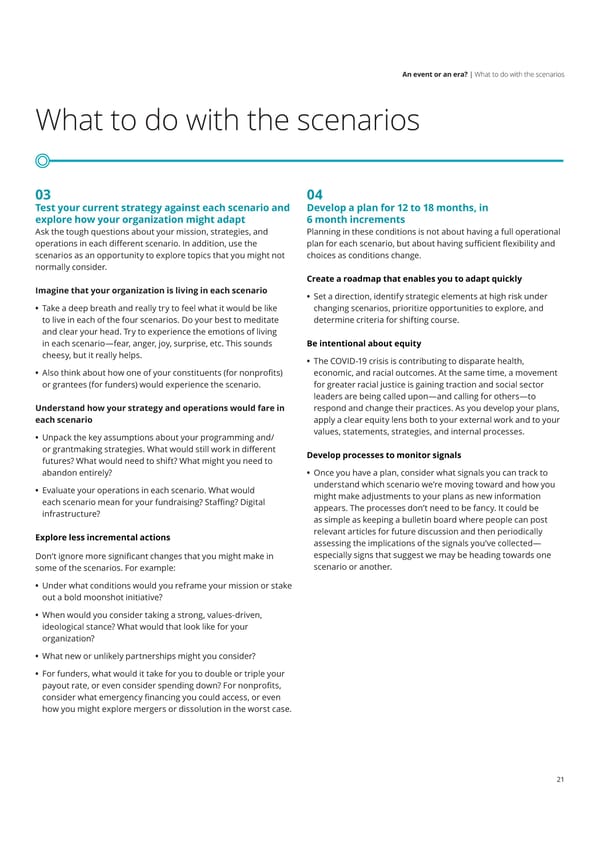An event or an era? | What to do with the scenarios What to do with the scenarios 03 04 Test your current strategy against each scenario and Develop a plan for 12 to 18 months, in explore how your organization might adapt 6 month increments Ask the tough questions about your mission, strategies, and Planning in these conditions is not about having a full operational operations in each different scenario. In addition, use the plan for each scenario, but about having sufficient flexibility and scenarios as an opportunity to explore topics that you might not choices as conditions change. normally consider. Create a roadmap that enables you to adapt quickly Imagine that your organization is living in each scenario • Set a direction, identify strategic elements at high risk under • Take a deep breath and really try to feel what it would be like changing scenarios, prioritize opportunities to explore, and to live in each of the four scenarios. Do your best to meditate determine criteria for shifting course. and clear your head. Try to experience the emotions of living in each scenario—fear, anger, joy, surprise, etc. This sounds Be intentional about equity cheesy, but it really helps. • The COVID-19 crisis is contributing to disparate health, • Also think about how one of your constituents (for nonprofits) economic, and racial outcomes. At the same time, a movement or grantees (for funders) would experience the scenario. for greater racial justice is gaining traction and social sector leaders are being called upon—and calling for others—to Understand how your strategy and operations would fare in respond and change their practices. As you develop your plans, each scenario apply a clear equity lens both to your external work and to your • Unpack the key assumptions about your programming and/ values, statements, strategies, and internal processes. or grantmaking strategies. What would still work in different Develop processes to monitor signals futures? What would need to shift? What might you need to abandon entirely? • Once you have a plan, consider what signals you can track to • Evaluate your operations in each scenario. What would understand which scenario we’re moving toward and how you each scenario mean for your fundraising? Staffing? Digital might make adjustments to your plans as new information infrastructure? appears. The processes don’t need to be fancy. It could be as simple as keeping a bulletin board where people can post Explore less incremental actions relevant articles for future discussion and then periodically assessing the implications of the signals you’ve collected— Don’t ignore more significant changes that you might make in especially signs that suggest we may be heading towards one some of the scenarios. For example: scenario or another. • Under what conditions would you reframe your mission or stake out a bold moonshot initiative? • When would you consider taking a strong, values-driven, ideological stance? What would that look like for your organization? • What new or unlikely partnerships might you consider? • For funders, what would it take for you to double or triple your payout rate, or even consider spending down? For nonprofits, consider what emergency financing you could access, or even how you might explore mergers or dissolution in the worst case. 21
 US Deloitte Monitor Institute Page 20 Page 22
US Deloitte Monitor Institute Page 20 Page 22